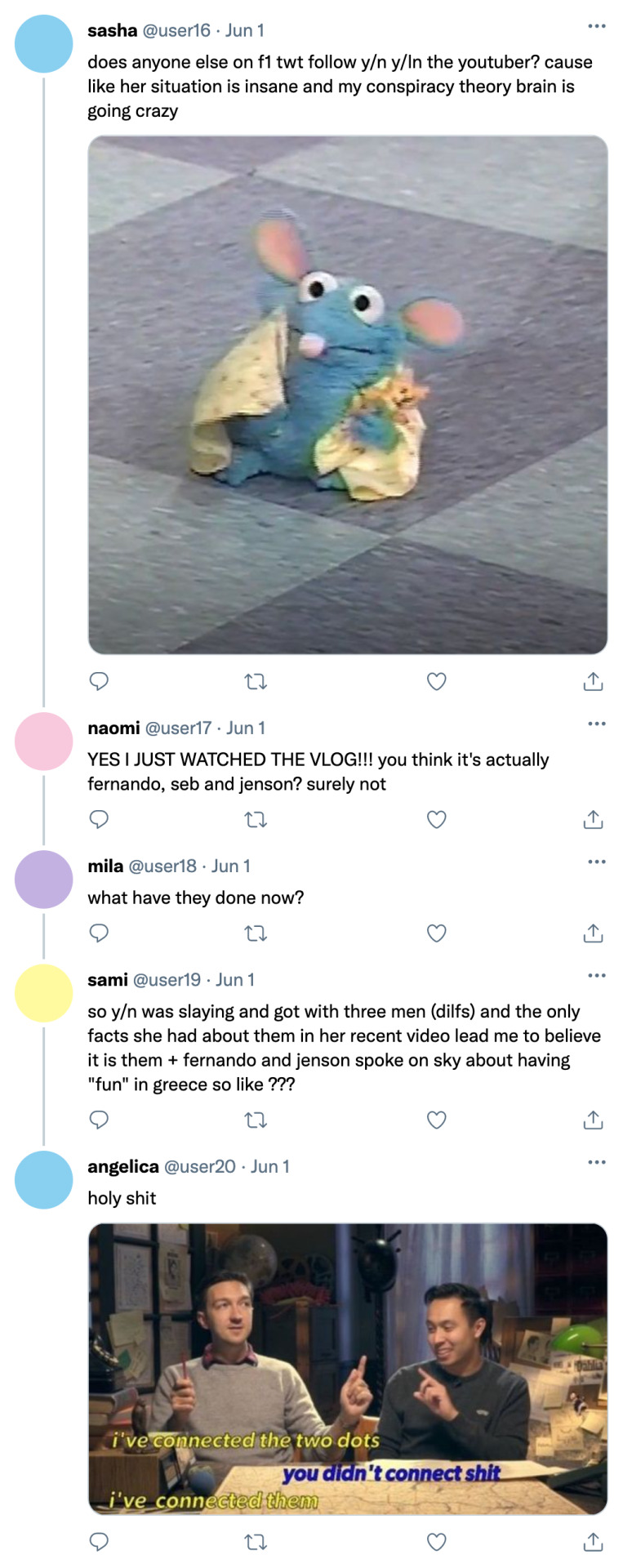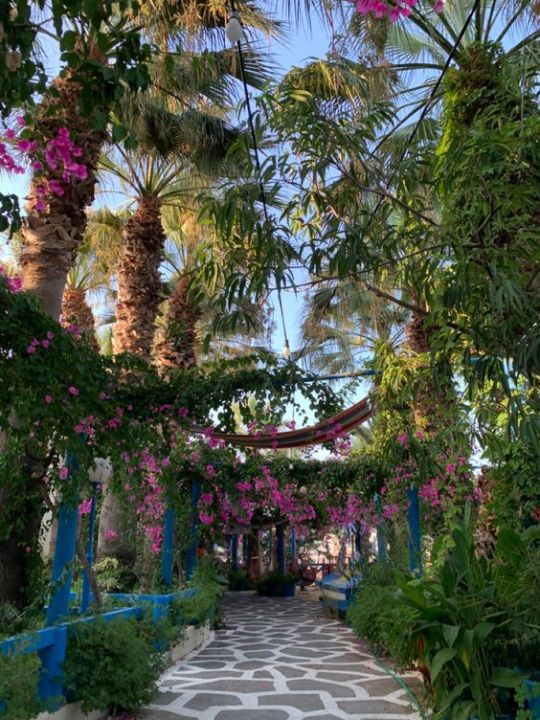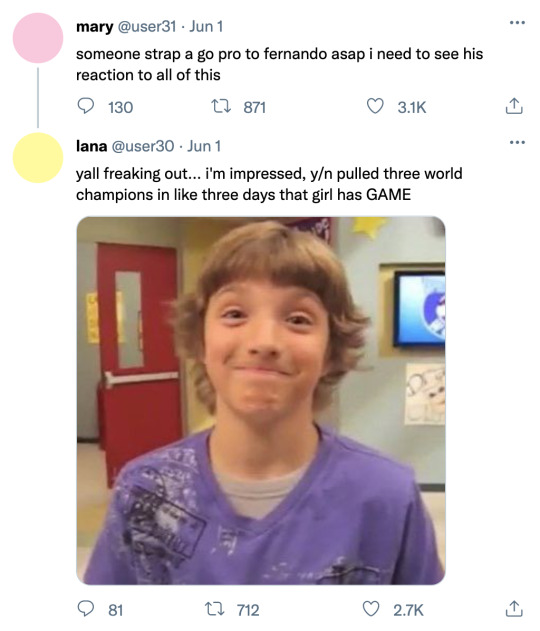#>Greece
Explore tagged Tumblr posts
Text
mamma mia | formula one social media au
drivers: sebastian vettel, jenson button and fernando alonso
what the hell is in the water in greece? why are pregnancy tests so expensive and why does seb name his vehicles like that?



fernandoalo_oficial



liked by maxverstappen1, aussiegrit and 803,450 others
location: greece
fernandoalo_oficial: had a great break in greece recharging the old batteries 🔋
view all comments
user1: old man who is this woman?
landonorris: who taught you to soft launch grandpa?
fernandoalo_oficial: hey! respect your elders
landonorris: you just called yourself old? and WHO IS THIS?
fernandoalo_oficial: none of your damn business kid
user2: why is he particularly dilfy lately?
user3: he's approaching silver fox territory i fear
jensonbutton: i see that greece was a popular spot for wold champions this break?
fernandoalo_oficial: i also saw, sad not to bump into you old friend :(
maxverstappen1: where was my invite ???
jensonbutton: cool world champions only
lewishamilton: excuse me?
fernandoalo_oficial: idk what to tell you it wasn't planned, me, jenson and sebastian just have good taste
sebastianvettel: i see mary goodnight was appreciated
fernandoalo_oficial: yes thank you for lending me your boat, huge hit with the ladies
sebastianvettel: very happy with my choice to get it deep cleaned before i got there
fernandoalo_oficial: first of all, i'm not dirty. second of all, thanks for the faith in my game big man
user4: i am so confused by this comment section I DID NOT WANT TO KNOW ALONSO FUCKED ON SEB'S BOAT ???

yourusername



liked by yourbff, oliviarodrigo and 1,340.987 others
tagged: yourbff
yourusername: (sober) brunch with a side of light baby daddy investigation
view all comments
user7: only y/n would end up in a mamma mia situation, stay strong
yourusername: omg i didn't even realise, but donna was always a bad bitch, so i will just be the same
user8: i can't believe i am watching a girl investigate her own baby daddies on the internet (i love this place)
yourbff: if we can't find the lucky men, at least they'll have a cool ass aunt
yourusername: all fun and games until you have to change a nappy
user9: i'm enjoying this saga, BUT, why can't we just wait and do a paternity test
yourusernmae: i still need to know them to do that... and being nosey is far more fun
user10: all i'm thinking is this girl has to have GAME for three dilfs in the span of like three days... RESPECT 🫡
user11: i am so invested in this... please be interesting people 🤞
jensonbutton


liked by sebastianvettel, fernandoalo_oficial and 401,330 others
jensonbutton: back on sky duty and bumped into a couple of familiar faces
view all comments
user12: who let these old men talk about their sex lives on a live broadcast?
user13: i am entertained tbf
user14: obsessed with both needing to reinforce the fact that they pulled in greece
user15: i need seb to jump in on this conversation ASAP
fernandoalo_oficial: not happy with you pinning all of my success on seb's boat mate
jensonbutton: was it all your charming personality?
fernandoalo_oficial: obviously
sebastianvettel: i can confirm that it's always all the boat
jensonbutton: is that a confession?
sebastianvettel: gentleman don't kiss and tell x
charles_leclerc: jesus christ and we're the generation ruining the sport?
jensonbutton: f1 has always been slutty, you guys are letting us down
maxverstappen1: clearly you guys are still active enough to keep up the reputation yourselves







sebastianvettel



liked by charles_leclerc, jensonbutton and 902,180 others
sebastianvettel: retirement is looking fun, glad to take mary goodnight out for her first spin
view all comments
user21: did he just say mary goodnight? SEB WHAT?
user22: omfg he is potential baby daddy two??
charles_leclerc: so seb got a bit too lucky in greece?
user23: CHARLES?
user24: i am losing my mind they were right, they are the baby daddies
user25: i knew as soon as she said a nando with a samurai tattoo
user26: @yourusername he's number two !!!!!
user27: @yourusername we found him, boat and all
landonorris: YOU'RE POTENTIAL BABY DADDY TWO SEB WHAT THE FUCK
sebastianvettel: i don't understand lando
landonorris: check your texts
user28: don't forget the others lando
landonorris: @fernandoalo_oficial check your texts (and forward it to jenson i don't have his number)
fernandoalo_oficial: okay?
yourusername: WHAT THE FUCKKKKKKKKKKKKKKKKKKKKKK
user29: i think someone needs to check on her

yourusername


liked by sebastianvettel, fernandoalo_oficial and 1,509,600 others
yourusername: i hot girl summer-ed a bit too close to the sun, what do you mean the three dilfs were f1 world champions?
comments are turned off on this post
sebastianvettel followed yourusername
fernandoalo_oficial followed yourusername
jensonbutton followed yourusername
note: AHHHHHH? idk if i love it or hate it? do i know who i plan on being the dad? no. but do i plan on expanding on this? yes. mamma mia chaos will return.
#f1 imagine#f1 x reader#f1 instagram au#f1 x you#f1#sebastian vettel instagram au#sebastian vettel x you#sebastian vettel x reader#sebastian vettel#sebastian vettel imagine#fernando alonso#fernando alonso imagine#fernando alonso x reader#fernando alonso instagram au#jenson button#jenson button imagine#jenson button x reader#jenson button instagram au
5K notes
·
View notes
Text
2024 Book Recommendations
I have an embarrassment of riches this year -- I had the chance to read a lot, and I kept finding so many good books. So many that instead of my normal ten recs, you're getting fifteen.
As always, these recommendations are not complete endorsements. Especially with the older books, there are definitely elements present that are questionable and even offensive.
Dragons – Pamela Wharton Blanpied (fantasy written as nonfiction, the first section recounts what happens when dragons invade Earth, the second section is a treatise on the habits and biology of dragons, and the third is a fascinating series of field notes from those who dare to befriend the monsters)
The Chatham School Affair – Thomas H Cook (mystery, a rural school, a beautiful lonely teacher, a lake, luscious language, loaded with atmosphere, you keep making and remaking your theories as you guess what happened)
Plain Bad Heroines – Emily M Danforth (mystery, braided narrative between the early twentieth century and present day, copious narrator commentary, cheeky footnotes, extremely funny but also extremely dark, gothic tropes, mostly female cast)
Cloud Cuckoo Land – Anthony Doerr (sci-fi, braided narrative spanning centuries, the story of one ancient text's journey through history, ancient Greece, medieval Constantinople, the present day in a small-town library, space travel and ai, it all comes together across the endless reach of time and you feel a lot)
Fanny Herself – Edna Ferber (pre-WW1 coming of age women's story, old-fashioned Anne of Green Gables thoughtfulness and sweetness in some places, rousingly modern in other places, strong focus on the heroine's Jewish identity, extremely funny narrative voice, the love of nature versus the industrial verve of Chicago, will our heroine keep her soul?)
The Vows of the Peacock – Alice Walworth Graham (Middle Ages, poetic fantastical language, Isabella the She-Wolf of France, messy politics, a darkly sexy historical villain, a complex but at times quite moving arranged marriage, an absorbing female protagonist)
A Thousand Ships – Natalie Haynes (Homer's women retell Homer's stories, angrily, tragically, bitchily, including many women you might not have thought of [and it isn't just the women Homer mentioned – we get into the weeds], the story is cut into bite-sized pieces that still offer filling food for thought)
The Masqueraders – Georgette Heyer (Georgian-era glitz and witty repartee, the heroine lives as a man, her brother lives as a woman, their father is full of wild schemes that might very well get them all executed for treason, the romance is a slow burn, and we get highwaymen)
Venetia – Georgette Heyer (a Regency-era GH romance, if you know GH then you know she's the author every other Regency romance writer is trying to be, it's funny, it's daring, it's tender, GH's romances are solid, but this one especially stands out for its strong-willed and capable heroine)
The Haunting of Hill House – Shirley Jackson (the house is a character, and not a nice one, psychological instability, unreliable narrator, creeping inchoate horror, whose hand am I holding, let's dwell on the unhappiness of being a smart woman in the 1950s)
Thornhedge – T Kingfisher (Sleeping Beauty but WHAT IF, I love the heroine, her name is Toadling, it's funny, it's romantic, it's thoughtful, it's even folkloric, there's a lot about ugly lady lake trolls, the prose reads beautifully, and it's compact, it doesn't waste your time and is short enough to knock out in a day or two)
The Silver Metal Lover – Tanith Lee (sci-fi, awkward dystopian-glam girl falls in love with a robot, whom she does not own, the sci-fi is as soft as pudding but it's more about the vibes anyway, inimitably stylish Tanith Lee weirdness, the robot is an absolute doll along with being a robot)
Pony Confidential – Christina Lynch (a pony is on a revenge mission against his former Horse Girl, but what if it was both funny and serious, but what if there was also a murder mystery, but what if we dwelt on human-animal negligence a la Black Beauty, but what if we also brought in Homer's Odyssey, it gets emotional)
The Princess and the Grilled Cheese Sandwich – Deya Muniz (fantasy, graphic novel, nonbinary protagonist lives as a man and is appalled to suddenly fall in love with the local heroic princess, gorgeous gorgeous shoujo-ish art, also very funny, it will make you crave cheese)
The Alice Network – Kate Quinn (WW1 and WW2, braided narrative, women acting as spies in occupied France, little-known historical events unfold on the page, so much Baudelaire, an old heroine and a young heroine and both are smart and bitter and compelling, but there's still room for some sweet romance and sharp humor)
#book recommendations#bookblr#reading#book recs#dragon#dragons#pamela wharton blanpied#the chatham school affair#thomas h cook#plain bad heroines#emily m danforth#cloud cuckoo land#anthony doerr#fanny herself#edna ferber#the vows of the peacock#alice walworth graham#a thousand ships#natalie haynes#the masqueraders#georgette heyer#venetia#the haunting of hill house#shirley jackson#thornhedge#t kingfisher#the silver metal lover#tanith lee#pony confidential#christina lynch
27 notes
·
View notes
Text


























World Bear Day
Advocating for the preservation of wild habitats to protect these magnificent creatures and the delicate balance of nature they represent.
Show some love, along with tons of respect, for these fluffy, strong animals who are so iconic – and also just enormous!
World Bear Day brings attention to how cool these mammals are, but the day is also meant to raise awareness for the ways that their habitats may be at risk and reminding people how they can help.
History of World Bear Day
World Bear Day has been celebrated for more than three decades since it was first established in 1992. Starting out small, this day has grown in scope and popularity over the years as it shows appreciation for these spectacular furry creatures.
Other than Australia and Antarctica, every continent has a bear that is native to its lands. But with six of the eight species of bears on the threatened or endangered list, bears face some difficult circumstances.
Because these are solitary animals that require a great deal of space to live and hunt, the places where bears live have been severely limited over the past several decades. Due to the expansion of logging, agriculture and climate change, as well as human encroachment, bear populations are declining.
Celebrate World Bear Day to show support and raise awareness about the needs of these marvelous creatures!
How to Celebrate World Bear Day
Get on board and have loads of fun by sharing in the excitement of World Bear Day. Celebrate by getting started with some of these ideas:
Learn Fun Facts About Bears
Perhaps one enjoyable way to get involved with World Bear Day might be to learn some interesting bits of trivia about them and then share with friends, family members and more. Certainly, parents and teachers will find that children benefit from sharing the excitement about and interest in this fascinating beast.
Consider some of these amazing facts about bears in honor of World Bear Day:
While they can usually only survive for around 25 years in the wild, when kept in captivity a bear’s life span may last up to twice that – up to 50 years!
Even though they are big, bears are also super fast. Depending on the species, a bear may be able to run upwards of forty miles per hour.
When a bear hibernates in the winter, it can spend up to 100 days or more than three months without waking up
Make a Charitable Donation
Many of the world’s non-profit organizations are dedicated to helping various animals by protecting their habitats.
World Bear Day would be an ideal time to show support by making a small donation on behalf of the bears. A quick online search will reveal a wide range of different bear charities, including the American Bear Association, the Grizzly Bear Foundation, the Great Bear Foundation and many more.
World Bear Day FAQs
What unusual laws exist about bears around the world?
Some U.S. states have quirky laws about bears. In Alaska, it’s illegal to wake a sleeping bear to take its photo.
Meanwhile, in Colorado, it’s unlawful to feed bears, as it can lead to dangerous habituation. These laws protect both people and wildlife.
Are there ancient myths about bears that influenced human culture?
Norse mythology revered bears as sacred. The god Odin was often associated with bears, symbolizing wisdom and strength.
In Ancient Greece, Artemis, the goddess of the hunt, was linked to bears, and her temple at Brauron featured a bear-worshipping ritual for young girls.
What is the connection between bears and constellations?
Bears have inspired celestial names. The Ursa Major (Great Bear) and Ursa Minor (Little Bear) constellations were named by ancient Greeks.
They believed Zeus placed them in the sky to honor a bear-shaped nymph named Callisto.
How have bears influenced modern literature and media?
Bears appear in iconic stories. A.A. Milne’s Winnie-the-Pooh depicts a friendly, honey-loving bear inspired by a real black bear at the London Zoo.
Baloo from Rudyard Kipling’s The Jungle Book represents wisdom and mentorship, reflecting cultural perceptions of bears as noble protectors.
How do indigenous people incorporate bears into their traditions?
The Ainu of Japan view bears as deities. Their Iyomante ceremony honors bears with songs, dances, and offerings.
North American Indigenous tribes often regard bears as spiritual guides, using their imagery in art and storytelling.
What are some fascinating bear behaviors beyond hibernation?
Bears can mimic human postures, sometimes sitting like people. Sloth bears carry their cubs on their backs, a rare behavior among bears. Grizzly bears also use tools, flipping over rocks with sticks to find insects.
How are bears featured in global art and crafts?
Russian Matryoshka dolls often depict bears, reflecting their cultural symbolism of strength.
Inuit artists carve polar bears from soapstone, showcasing their deep connection with Arctic wildlife. These crafts preserve traditions and honor bears
What unusual foods do bears eat in the wild?
Bears have eclectic diets. Black bears eat ants, termites, and even carrion.
Grizzlies devour moths, sometimes consuming 40,000 in a day. Pandas, although primarily bamboo eaters, occasionally eat eggs and small animals.
What are some strange bear-related superstitions?
In medieval Europe, people believed carrying a bear tooth could ward off illness. In Finland, mentioning bears by name was taboo, so euphemisms like “honey eater” were used to avoid bad luck.
What are some quirky traditions involving bears in sports?
The Canadian Football League’s Calgary Stampeders have a bear mascot named Ralph.
During games, fans toss bear-themed items, including stuffed animals, for charity drives. The tradition combines fun and philanthropy.
Source
#Grizzly bear#North American brown bear#Polar Bear#Bronx Zoo#New York City#San Diego Zoo#Spectacled bear#Zoo Zürich#Sun bear#Zoo Basel#Switzerland#I saw wild bears but I couldn't take pics of them#animal#travel#original photography#vacation#tourist attraction#landmark#USA#World Bear Day#23 March#WorldBearDay
3 notes
·
View notes
Text
Overview
The fundamental concern as we look to reform health in America is the known reality that most chronic diseases that afflict Americans are predominantly lifestyle induced; and the belief is that the vast majority of heart attacks and strokes could be prevented if people were willing to adopt healthy lifestyle behaviors. In addition, healthy lifestyles would impact a significant number of cancers which are also believed to be related to lifestyle exposures, especially to obesity, cigarettes, and other toxins.
Over the past 50 years, the health of Americans has gotten worse, and now 71% of Americans are overweight or obese—not 66%, which was reported 5 years ago.1 That means a staggering 100 million people in America are obese. Today, eating processed foods and fast foods may kill more people prematurely than cigarette smoking.2
Authorities determined the 71% figure by classifying people with a body mass index (BMI) over 25 kg/m2 as overweight or obese. Yet in long-lived societies such as in the “Blue Zones” (Ikaria, Greece; Sardinia, Italy; Okinawa, Japan; the Nicoya Peninsula of Costa Rica; and Loma, Linda California) and wherever we find groups of centenarians, we observe a healthy BMI below 23 kg/m2, not 25 kg/m2. If we use above 23 kg/m2 as the demarcation for overweight or obesity, then we find that 88% of Americans are overweight. And out of the approximately 10% that are of normal weight, the majority of those so-called “normal weight individuals” are either cigarette smokers, or suffer from alcoholism, drug addiction or dependency, autoimmune disease, occult cancers, inflammatory disorders, autoimmune conditions, digestive disorders, irritable bowel syndrome, and other illnesses that lower their body weight. Therefore, perhaps that only about 5% of the American population is at a normal weight as a result of eating healthy and living a healthy life. A recent study documented that only 2.7% of Americans adopt a relatively healthy lifestyle by combining exercise with healthy eating.3 The Standard American Diet (SAD) is clearly not a healthy diet.
I use the term “Fast Food Genocide” because most don’t understand the depth and breadth of the harm as a large segment of our society eats a diet worse than the dangerous SAD. Many people recognize that junk food, fast food, processed food, white flour, sugar, maple syrup, honey, agave nectar, and all the junk people are eating contribute to in obesity, diabetes, heart attacks, strokes, dementia and cancer, but many don’t realize the strong causative role an unhealthy diet may have in mental illness. Currently, 1 in 5 Americans suffers from a psychiatric disorder. And many people don’t realize the harm that processed foods have on Americans living in urban areas where they don’t have easy access to whole, fresh foods.
These unfortunate folks live in what we call “food deserts,” with reduced availability to fresh fruits and vegetables. Because of the limited access to supermarkets, they eat more unhealthy fast and processed foods and end up having 7 times the risk of early-life stroke (before age 45), putting people in nursing homes in their 30s, 40s, and 50s.4-7
The vulnerable poor in these areas also have double the risk of heart attack, double the risk of diabetes, and 4 times the risk of renal failure8-10; Unfortunately, the decrease in life span due to food inequality is shocking but rarely discussed. A substantial proportion of people in these urban environments are overweight, prediabetic, or fully diabetic. Researchers determined that compared with other areas in America with easy access to supermarket food, that the YPLL (Years of Potential Life Lost) for an overweight diabetic living in a zone classified as a food desert was a shocking 45 years!11,12
A link may even exist between fast food, processed food, commercial baked goods, and sweets and destruction of brain cell and a lowering of intelligence. Candy and sweetened baked goods may even stimulate the brain in an addictive fashion, which can lead to more serious illnesses.
The nutritional fundamentals accepted by the World Health Organization and most nutritional authorities today include vegetables, beans, nuts, seeds, and fruit as healthy foods; and salt, saturated fat, and excess sugar as disease causing. Excessive amounts of animal products may lead to premature aging, increased risk of chronic disease and higher all-cause mortality. Multiple studies have been published on hundreds of thousands of people, followed for decades showing that the objective endpoint of death is increased with higher amounts of animal product consumption.13-17 Furthermore, refined carbohydrates may not just lead to being overweight and diabetic but also contribute to dementia, mental illness, and cancer.18-21 There is considerable evidence today that heart disease is not only promoted by saturated fat and increased animal products but also by refined carbohydrates, including white rice, white bread, sugar, honey, maple syrup, and agave nectar.22-25
Research has shown that excess calories shorten lifespan, whereas moderate caloric restriction slows the aging process and protects the body and brain. Americans consume more calories than any other population; and they consume foods, many of which have minimal or no nutritional value (soda and alcohol as examples). So let’s consider the individual who is consuming 50 excess calories per day. What will be the short- and long-term result? Fifty excess calories per day, over and above your basic metabolic needs, over a 10-year period, adds about 50 pounds of extra body weight. The excess weight increases the risk of multiple chronic illnesses, cancers, and also takes many years of life away from the individual simply as a result of consuming only 50 calories a day too many.
Conversely, if an individual consumed 50 calories a day less that their metabolic requirements what would happen then? Would he or she become too thin, anorexic, and unhealthy? Would their bones fall apart? Obviously not! When you moderately caloric-restrict, even a small amount such as 50 to 100 calories a day, weight remains about the same, the person is slim, not too thin, and healthy. He or she will have a lower body fat percentage, and the skeletal mass, bones, and muscle mass are strong. In this scenario, the metabolic rate would slow down accordingly. The respiratory quotient, (the number of calories lost through respiration) would decrease, the body temperature would lower, and thyroid function would decrease slightly, all lowering the metabolic rate, which overall may result in a slowing of the aging process. The secret to a long life and freedom from chronic disease may be simply to moderately reduce calories in order to slow down our metabolic rate. The only behavior proven scientifically to dramatically increase life span in every species of animals, including primates, is to lower caloric intake while maintaining an environment of micronutrient adequacy, assuring that we have exposure to every micronutrient humans need. The American diet is also deficient in antioxidants and phytochemicals that are needed for normal immune function, for maximizing brain health, protecting against dementia, chronic illness, cancer, and premature aging.
to continue reading the rest of the article, click HERE or the header to go to the article directly in full
2 notes
·
View notes
Text
"BMCR 2009.10.48
Ancient Greece and Ancient Iran: Cross-Cultural Encounters. 1st International Conference (Athens, 11-13 November 2006)
Seyed Mohammad Reza Darbandi, Antigoni Zournatzi, Ancient Greece and Ancient Iran: Cross-Cultural Encounters. 1st International Conference (Athens, 11-13 November 2006). Athens: National Hellenic Research Foundation; Hellenic National Commission for UNESCO; Cultural Center of the Embassy of the Islamic Republic of Iran, 2008. xxix, 377. ISBN 9789609309554. €60.00 (pb).
Review by
Margaret C. Miller, University of Sydney. [email protected]
[Authors and titles are listed at the end of the review.]
The volume commemorates a landmark occasion, when the national research centres of Iran and Greece collaborated in a multi-national interdisciplinary conference on the history of exchange between Iran and Greece. Its nearly 400 pages reflect a strong sense of its symbolic importance. Papers span the Achaemenid through the Mediaeval periods and address the theme of exchange from the perspective of many disciplines — history, art, religion, philosophy, literature, archaeology. The book thus brings together material that can be obscure outside the circle of specialists, and in a manner that is generally accessible; the wide range of topics and periods included is a strength. Excellent illustrations often in colour enhance the archaeological contributions, as does inclusion of hitherto unpublished material.
The volume commences with a brief section on what might be called Greek textual evidence (Tracy, Petropoulou, Tsanstanoglou), followed by papers on interaction in Sasanian through mediaeval Persia (Azarnoush, Alinia, Venetis, Fowden), four papers discussing Achaemenid, Seleucid and Parthian history (Weiskopf, Ivantchik, Tuplin, Aperghis), aspects of the archaeology of Persepolis and Pasargadae (Stronach, Talebian, Root, Palagia), and ends with essays on the receptivity to Achaemenid culture in the material culture of the western empire and fringes: Cyprus, Turkey, Greece (Zournatzi, Lintz, Summerer, Paspalas, Ignatiadou, Sideris, Triantafyllidis), followed by a paper on traces of Greek material culture in the archaeology of (Seleucid) Iran (Rahbar). The wealth of vehicles, contexts and levels of exchange attested through the ages is both eye-opening and exciting. While there is unfortunately little attempt at globalizing synthesis or theoretical modelling, the analytical methods and collections of data in the individual contributions will aid future work in the area.
Stephen Tracy starts the volume with a synchronic analysis of the ways in which first Aeschylus, then Homer, play upon the prejudices of their audience against ” barbaroi” and then show the human quality of the enemy. In Persai, the Athenians are anonymous in contrast with the delineated personalities of the Persian royal family; in the Iliad, Achilles is “not very likeable” but learns humanity from the sorrow of Priam. Both poets focus on common humanity that transcends short-term hostilities.
Angeliki Petropoulou offers a detailed analysis of Herodotus’ account of the death of Masistios and subsequent mourning (Hdt. 9.20-25.1). Herodotus played up the heroic quality of Masistios’ death, stressing his beauty and height, qualities appreciated by both Greeks and Persians. The fact that Masistios seems to have gained the position of cavalry commander in the year before his death, coupled with the likelihood that his Nisaian horse with its golden bridle was a royal gift, suggests he had been promoted and rewarded for bravery.
Kyriakos Tsantsanoglou discusses the Derveni papyrus’ mention of magoi (column VI.1-14). Though the papyrus dates 340-320, the text was composed late fifth century BC, making the apparently Iranian content especially important. Both the ritual described and the explanation for it cohere with elements known from later Persian sources as features of early Iranian religious thought. While the precise vehicles of transmission of such knowledge to the papyrus are unknowable, the papyrus is the first certain documentation of the borrowing of Iranian ideas in Greek (philosophical) thought.
On the Iranian side exchange of religious ideas is documented by Massoud Azarnoush in the iconography of a fourth-century AD Sasanian manor-house he excavated at Hajiabad 1979.1 Moulded stucco in the form of divine figures included dressed and naked females identified with Anahita. The very broad shoulders of the Hellenistically dressed Anahita fit an Iranian aesthetic; the closest parallel for the slender naked females is found not in the cognate Ishtar type but in the Aphrodite Pudica type. Reliefs of naked boys, of uncertain relationship with Anahita, have attributes of fertility cult in the (Dionysian?) bunches of grapes they hold and in the ?ivy elements of their headdress.
Sara Alinia offers a brief but fascinating account of the development of state-sponsored religion hand-in-hand with state-sponsored persecution of religious elements that were deemed to be affiliated with another state: the Christian Late Roman Empire and the Zoroastrian Sasanian Empire. She documents the rise of religion as a tool of inter-state diplomacy and vehicle for inter-state rivalry; religion was but one facet of the political antagonism between the two.
Evangelos Venetis studies the cross-fertilization between Hellenistic and Byzantine Greek romance and Iranian pre-Islamic and Islamic romantic narrative. Persian elements are found in Hellenistic romance; Hellenistic themes contribute to Persian epics. The fragmentary nature of texts ranging 2nd -11th/14th c. AD and the lack of intermediary texts are serious impediments which may yet be overcome. The Alexander Romance, known in Iran from a Sasanian translation, contributed to the form and detail of the Shahname, as well as to other Persian epics.
Garth Fowden outlines the complex history of the creation, translation, wide circulation and impact of the pseudo-Aristotelian texts on religious thought. Aristotle’s works were translated into Syriac in the 6th c. and in the mid 8th c. into Arabic. Arab philosophers, attracted to the idea of Aristotle as counsellor of kings, updated him. Owing to his remoteness in time, “Aristotle” offended neither Muslim nor Christian. The Letters of Alexander, Secret of Secrets and al-Kindi’s sequel of Metaphysics, the Theology of Aristotle, contributed significantly to the philosophical underpinnings of both Muslim and Christian theology; the last remains an important text in teaching at Qom.
Michael N. Weiskopf argues that Herodotos’ account of the Persian treatment of Ionia after the Ionian revolt constitutes “imperial nostalgia” — the popular memory of how good things were under a past regime, in the context of a new regime. Herodotos 6.42-43, stressing the administrative efficiency and fairness of Artaphernes’ arrangements, allows a reading of Mardonios’ alleged imposition of democratic constitutions (so dissonant with the subsequent reported governing of Ionian states) as imperial nostalgia, to be contrasted with the inconsistent and unfair treatment of the Ionians by the Athenians of Herodotos’ own day.
Askold I. Ivantchik publishes two Greek inscriptions from Hellenistic Tanais in the Bosporos (and reedits a third). Evidently private thiasos inscriptions, they confirm that the city was already in 2nd or 1st century BC officially divided into two social (presumably ethnic) groups: the Hellenes and the Tanaitai, presumably Sarmatians, on whose land the city was founded in the late 3rd century BC. A thiasos for the river god Tanais includes members with both Greek and Iranian names, showing that private religious thiasoi were an important vehicle for breaking down social barriers between the two populations of the city.
Two papers offer contrasting interpretations of the evidence for Seleucid retention of Achaemenid institutions. That there were parallels between structures of the different periods is uncontested; the question is whether the parallels signify a deliberate programme of Seleucid self-presentation as the “heirs of the Achaemenids.” Christopher R. Tuplin argues that acquisition of the empire involved adoption of the Achaemenid mantle in some contexts and maintenance of those structures that worked, but that the balance of evidence suggests no conscious policy of continuation, and considerable de facto alteration of attitude and form. He suggests that the evidence of continuity of financial (taxation) structures — a major part of Aperghis’ argument — is ambiguous, at best. The treatment and divisions of territory, most notably the “shift of centre of gravity” from Persis to Babylonia, argue more for disruption than continuity.
G. G. Aperghis gives the case for a deliberate Seleucid policy of continuation of many Achaemenid administrative practices. He points to the retention of the satrapy as basis of administrative organization; use of land-grants (albeit to cities rather than individuals); continuing royal support of temples; maintenance of the Royal Road system (n.b. two Greek milestones, one illustrated in this volume by Rahbar); the retention of two separate offices relating to financial oversight. He suggests that the double sealing of transactions in the Persepolis Fortification Tablets metamorphosed into the double monogram on Seleucid coinage. Further field work in Iran, like that outlined by Rahbar (see below), will settle such contested matters as whether the many foundations of Alexander had any local impact. At present, Tuplin offers the more persuasive case.
David Stronach, excavator of Pasargadae, gives his considered opinion on the complex nexus of issues relating to the date of Cyrus’ constructions at Pasargadae. Touching upon the East Greek and Lydian contribution to early Achaemenid monumental architecture in stone and orthogonal design principles, Cyrus’ conquest chronology and the Nabonidus Chronicle, Darius’ creation of Old Persian cuneiform, the elements of the Tomb of Cyrus, and new evidence confirming the garden design, he argues that the chronology of the constructions at Pasargadae indirectly confirms the date of the conquest of Lydia around 545.
Mohammad Hassan Talebian offers a diachronic analysis of Persepolis and Pasargadae, starting with a survey of the Iranian and Lydian elements in their construction. Modern interventions include the ill-informed and damaging activities of Herzfeld and Schmidt at Persepolis in the 1930s, the stripping away of the mediaeval Islamic development of the Tomb of Cyrus, and the damage to the ancient city of Persepolis in preparation for the 2500-anniversary celebrations in 1971. Recent surveys in the region compensate to some degree. Talebian urges the importance of attention to all periods of the past rather than a privileged few.
Margaret Cool Root continues her thought-experiment in exploring how a fifth-century Athenian male might have viewed Persepolis.2 Sculptural traits such as the emphasis on the clothed body and nature of interaction between individuals would have seemed to the hypothetical Athenian to embody a profoundly effeminate culture. Yet Root’s study of the Persepolis Fortification Tablet sealings, their flashes of humour and playfulness in their utilisation on the tablets, reveals a world in which oral communication — idle chit-chat — perhaps bridged the cultural divide. She concludes that a visiting Greek might well have learned how to read the imagery like an Iranian.
Olga Palagia argues that the most famous Greek artefact found at Persepolis, the marble statue of “Penelope”, was not booty but a diplomatic gift from the people of Thasos: its Thasian marble provides a workshop provenance. The “Polygnotan” character, seen also in the Thasian marble “Boston Throne,” possibly from the same workshop, suits the prestige of the gift: Thasos’ great artist, the painter Polygnotos, is also attested as a bronze sculptor. A putative second Penelope in Thasos, taken to Rome in the imperial period with the “Boston Throne,” would have served as model for the Roman sculptural versions.
Antigoni Zournatzi offers the first of a series of regional studies documenting receptivity to Persian culture in the western empire and beyond, with a look at Cyprus. Earlier scholarship focused on siege mound and palace design; receptivity can be tracked in glyptic, toreutic, and sculpture. Western “Achaemenidizing” seals may be Cypriote; Persianizing statuettes may reflect local adoption of Persian dress (or Persian participation in local ritual). The treatment of beard curls on one late 6th century head may reflect Persian sculptural practice. Zournatzi suggests that Cypro-Persian bowls and jewellery were produced not for local consumption but to satisfy tribute requirements.
Yannick Lintz announces a project to compile a comprehensive corpus of Achaemenid objects in western Turkey, an essential step in any attempt to understand the period in the region.3 Particular challenges lie in matters of definition, both of “Achaemenid” and “west Anatolian” traits. The state of completion of the database is not clear; one is aware of a volume of excavated material in museums whose processing and publication was interrupted and can only wish her well in what promises to be a massive undertaking.
Lâtife Summerer continues her publication of the Persian-period Phrygian painted wooden tomb at Tatarli in western Turkey with discussion of the different cultural elements of its iconographic programme.4 The friezes of the north wall especially present Anatolian traditions; the east wall friezes of funerary procession and battle (between Persians and nomads) offer a mix of Persian and Anatolian. New Hittite evidence clinches as Anatolian the identification of the cart with curved top familiar in Anatolo-Persian art; it carries an effigy of the deceased. Alexander von Kienlin’s appendix expands the cultural mix presented by the tomb with his demonstration that its Lydian-style dromos was an original feature.
Stavros Paspalas raises questions about the vehicles and route of cultural exchange between the Persian Empire and Macedon through analysis of Achaemenid-looking lion-griffins on the façade of the later fourth century tomb at Aghios Athanasios. He identifies a pattern of specifically Macedonian patronage of Achaemenid imagery also in southern Greece in the fourth century in such items as the pebble mosaic from Sikyon and the Kamini stele from Athens. Enough survives to suggest independent local Macedonian receptivity to Persian ideas rather than a secondary derivation through southern Greece.
Despina Ignatiadou summarises succinctly the growing corpus of Achaemenidizing glass and metalware vessels in 6th-4th century BC Macedon. Three foreign plants lie behind the forms of lobe and petal-decoration on phialai, bowls, jugs, and beakers: the central Anatolian opium poppy, the Egyptian lotus (white and blue types) and the Iranian/Anatolian (bitter) almond. The common denominator is their medicinal and psychotropic qualities; Ignatiadou suggests that their appearance on vessels has semiotic value and that such drugs were used in religious and ritual contexts along with the vessels that carry their signatures, perhaps especially in the worship of the Great Mother.
Athanasios Sideris outlines the range of issues related to understanding the role of Achaemenid toreutic in documenting ancient cultural exchange: production ranges between court, regional, and extra-imperial workshops, not readily distinguishable. The inclusion of little-known material from Delphi and Dodona enriches his discussion of shape types. He works toward identification of local workshops, both within and without the empire, based especially on apparent local preferences in surface treatment. The geographical range of production is one area that will benefit from further international research collaboration.5
Pavlos Triantafyllidis focuses on the wealth of material from Rhodes, both sanctuary deposits and well-dated burials, that attests a history of imports from Iran and the Caucasus even before the Achaemenid period. Achaemenid-style glass vessels start in the late 6th century with an alabastron and petalled bowl, paralleled in the western empire, and carry on through the fourth century. An excavated fourth-century glass workshop created a series of “Rhodio-Achaemenid” products that dominated Rhodian glassware through the early third century. This microcosmic case study brilliantly exemplifies a much broader phenomenon.
Mehdi Rahbar outlines and illustrates archaeological material, some not previously published, that will be fundamental in future discussions of Seleucid Iran. The as of yet limited corpus includes: modulation of Greek forms perhaps to suit a local taste (Ionic capital from the temple of Laodicea, Nahavand, known from an 1843 inscription of Antiochus III; fragmentary marble sculpture of Marsyas?), amalgam of Iranian and Greek (milestone in Greek with Persepolitan profile), Greek import (Rhodian stamped amphora handle ΝΙΚΑΓΙΔΟΣ from Bisotun);6 and Iranian adoption of Greek decorative elements (vine leaves, grapes, and acanthus patterns, for which compare Azarnoush’s stucco).
The volume concludes with a brief overview of ancient Iranian-Greek relations and their modern interpretation by Shahrokh Razmjou.
The inclusion of the texts of the introductory and concluding addresses made on the occasion of the conference in particular allow the reader to comprehend its aims: hopes of exchange in the modern world through assessing exchange in the past. A number of the papers make it very clear that collaboration between specialists of “East” and “West” in both textual and archaeological research could yield great gains for all periods of history and modes of analysis. The conference and its publication, therefore, succeed at a variety of levels.
Editing such a volume must have been a real challenge and it is to the credit of authors and editors that throughout the whole volume, I found only a handful of minor infelicities and typographical errors, none of which obscure meaning.7
Contents: Stephen Tracy, “Europe and Asia: Aeschylus’ Persians and Homer’s Iliad” (1-8) Angeliki Petropoulou, “The Death of Masistios and the Mourning for his Loss” (9-30) Kyriakos Tsantsanoglou, “Magi in Athens in the Fifth Century BC?” (31-39) Massoud Azarnoush, “Hajiabad and the Dialogue of Civilizations” (41-52) Sara Alinia, “Zoroastrianism and Christianity in the Sasanian Empire (Fourth Century AD)” (53-58) Evangelos Venetis, “Greco-Persian Literary Interactions in Classical Persian Literature” (59-63) Garth Fowden, “Pseudo-Aristotelian Politics and Theology in Universal Islam” (65-81) Michael N. Weiskopf, “The System Artaphernes-Mardonius as an Example of Imperial Nostalgia” (83-91) Askold I. Ivantchik, “Greeks and Iranians in the Cimmerian Bosporus in the Second/First Century BC: New Epigraphic Data from Tanais” (93-107) Christopher Tuplin, “The Seleucids and Their Achaemenid Predecessors: A Persian Inheritance?” (109-136) G. G. Aperghis, “Managing an Empire—Teacher and Pupil” (137-147) David Stronach, “The Building Program of Cyrus the Great at Pasargadae and the Date of the Fall of Sardis” (149-173) Mohammad Hassan Talebian, “Persia and Greece: The Role of Cultural Interactions in the Architecture of Persepolis-Pasargadae” (175-193) Margaret Cool Root, “Reading Persepolis in Greek—Part Two: Marriage Metaphors and Unmanly Virtues” (195-221) Olga Palagia, “The Marble of the Penelope from Persepolis and its Historical Implications” (223-237) Antigoni Zournatzi, “Cultural Interconnections in the Achaemenid West: A Few Reflections on the Testimony of the Cypriot Archaeological Record” (239-255) Yannick Lintz, “Greek, Anatolian, and Persian Iconography in Asia Minor : Material Sources, Method, and Perspectives” (257-263) Latife Summerer, “Imaging a Tomb Chamber : The Iconographic Program of the Tatarli Wall Paintings” (265-299) Stavros Paspalas, “The Achaemenid Lion-Griffin on a Macedonian Tomb Painting and on a Sicyonian Mosaic” (301-325) Despina Ignatiadou, “Psychotropic Plants on Achaemenid Style Vessels” (327-337) Athanasios Sideris, “Achaemenid Toreutics in the Greek Periphery” (339-353) Pavlos Triantafyllidis, “Achaemenid Influences on Rhodian Minor Arts and Crafts” (355-366) Mehdi Rahbar, “Historical Iranian and Greek Relations in Retrospect” (367-372) Shahrokh Razmjou, “Persia and Greece: A Forgotten History of Cultural Relations” (373-374)
Notes
1. The site is fully published in: M. Azarnoush, The Sasanian manor house at Hajiabad, Iran (Florence 1994).
2. The first appears as “Reading Persepolis in Greek: gifts of the Yauna,” in C. Tuplin, ed., Persian Responses: Political and Cultural Interaction with(in) the Achaemenid Empire (Swansea 2007) 163-203.
3. Deniz Kaptan is similarly compiling a corpus of Achaemenid seals and sealings in Turkish museums.
4. Other studies: “From Tatari to Munich. The recovery of a painted wooden tomb chamber in Phrygia”, in I. Delemen, ed., The Achaemenid Impact on Local Populations and Cultures (Istanbul 2007), 129-56; “Picturing Persian Victory: The Painted Battle Scene on the Munich Wood”, in A. Ivantchik and Vakhtang Licheli, edd., Achaemenid Culture and Local Traditions in Anatolia, Southern Caucasus and Iran: New Discoveries (Leiden/Boston 2007: Ancient Civilizations from Scythia to Siberia 13), 3-30.
5. Considerable progress is being made, e.g., in Georgia: V. Licheli, “Oriental Innovations in Samtskhe (Southern Georgia) in the 1st Millennium BC,” and M. Yu. Treister, “The Toreutics of Colchis in the 5th-4th Centuries B.C. Local Traditions, Outside Influences, Innovations,” both Ivantchik / Licheli, edd., Achaemenid Culture and Local Traditions in Anatolia��(previous note), 55-66 and 67-107.
6. For early 2nd c. date of this fabricant, see Christoph Börker and J. Burow, Die hellenistischen Amphorenstempel aus Pergamon: Der Pergamon-Komplex; Die Übrigen Stempel aus Pergamon (Berlin 1998), cat. no. 274-286; one example has a context of ca. 200 BC.
7. Except possibly the misprint on p. 357, line 8 up, where “second century” should presumably be “second quarter” (of the fourth century)."
2 notes
·
View notes
Text
How Do Blue Zones Teach Us About Healthy Aging?

The “Blue Zones” are astonishing regions in the world which are home to people who tend to live and remain healthy into their nineties, most having avoided chronic diseases or age-associated decline. This phenomenon leaves us wondering, what sets them apart? What do they do on a daily basis, what do they eat, and what kind of environment do they live in?
By analysing the deep-seated principles and cuisines of the zones, we begin to grasp the unblemished lifestyle and values that exist. Understanding these Blue Zones and their secrets allows us to have a better comprehension of true well-being and aging in our modern world.
What Are Blue Zones and Why Do They Matter?
The term “Blue Zones” was first used by researcher and author Dan Buettner, who, along with a team of scientists and demographers, discovered five regions across the globe where people live much longer and healthier than the average global life expectancy. These areas are Okinawa (Japan), Sardinia (Italy), Nicoya Peninsula (Costa Rica), Ikaria (Greece), and Loma Linda (California, USA).
What is most remarkable about these communities is not only their lifespan, but their health span. People living in Blue Zones usually live to an old age without most of the diseases common in industrialized nations, like heart disease, diabetes, and obesity. They are a contemporary example of healthy aging and prove that we can not only live longer, but age with vitality and independence.
To understand Blue Zone lifestyle is not simply a matter of appreciation; it is about how to incorporate these lessons into our own existence.
Exploring the Five Blue Zones
The Blue Zones all display distinct cultures and environmental traits; however, all regions showcase distinctive factors that sustain quality of life and longevity.
Okinawa, Japan, has long retained the custom of celebrating the advanced age among its residents. The elderly remain highly active, with lots of sweet potatoes, tofu, and vegetables making up their diet. The elderly are also revered in Okinawa, and served as a form of inspiration while ‘Ikigai’ gives Japanese a reason to get out of bed every day.
Sardinia, Italy, particularly the mountainous district of Barbagia, has one of the highest concentrations of centenarian males. In addition to the Mediterranean diet, strong family ties, and physical activity from herding and walking, contribute to longevity.
Individuals living on the Nicoya Peninsula in Costa Rica recognize ‘Plan de Vida’ as a purpose driven physical occupation which, alongside water full of calcium, significantly contributes to longevity. Meanwhile those from Ikaria, Greece fend off dementia while living a slow-paced lifestyle filled with afternoon naps and a olive oil, wild green, and legumes rich diet.
Lastly, Loma Linda in California does not fail to stand out because of the plant based diet followed by the local Seventh Day Adventists and their alcohol, tobacco, and community centered lifestyle.
The Lifestyle Patterns That Promote Longevity
Most people try to gate keep the most beneficial ideas from the blue zones. For example, healthy aging doesn't come from expensive routines or intense interventions. Far from it. It’s rooted in practices that are consistent and done on a day to day basis, accumulating over a lifetime.
Stress management is significantly low in all blue zones. Spiritual activities, and even spending time in nature, greatly contribute toward managing stress. Frequent prayer at Loma Linda or meditation in Okinawa showcases cultures that massively value stress relief.
Movement on a day to day basis is something all blue zone citizens prioritize. Rather than rotating between ergyllic exercises scheduled into the week, people are “busy” engaging with active pastimes like gardening, cleaning, walking, and other labor. Cardiovascular health, flexibility, mental clarity, and countless other benefits stem from this sort of lifestyle.
Social connection is another pillar that contributes towards aging healthily. The presence of robust social networks from families, religious communities, and even old friendships all aid in healthy aging. With them comes the vital component of emotional well being, reducing the chances of depression and cognitive decline.
Studies show that lacking a sense of purpose can lead to greater stress, heart problems, and a shortened lifespan. Being grounded in direction in life is critical, hence the reason for having “Ikigai” in Japan and “Plan de Vida” in Costa Rica.
What We Can Learn from Blue Zone Diets
Nutrition is an important part of aging well. It is the diet of the blue zone residents that contributes the most to healthy aging. Different areas have their unique traditional cuisines, but there are overarching similarities.
Blue zone diets focus on vegetables as their main source of nutrition. Whole grains, legumes, nuts, seeds, and a variety of fruits and vegetables form the processed diet. Blue zones residents consume these foods along because they have an abundance of essential vitamins, antioxidants, and fiber which help in combating oxidative stress and inflammation. These two are known to be the leading factors of unhealthy aging.
In Mediterranean blue zones, foods that are rich in healthy fats like nuts, seafood, and olive oil are also a good source of energy. They also increase the chances of having a healthy heart, and lower the risks of the resident getting brain related health issues.
Meat is eaten only a few times a month which is very sparing, also dairy products such as cow’s milk are very limited, with goat’s milk more commonplace. There is little to no processed foods or sugars consumed within their diet. This results in their bodies being stimulated by wholesome nutrition which enhances their energy, immune functions, and aids in digestion.
Drinking minor doses of red wine, especially with food is a habit observed in Ikaria and Sardinia. These practices aren’t seen in the other blue zone areas, like Loma Linda, but it does occur in a social context and is done in moderation.
By embracing an anti-aging lifestyle rooted in plant-based, fiber-rich foods, we can adopt a “eat to live” mentality that nurtures long-term health rather than short-term gratification.
Psychological and Social Wellness as Anti-Aging Tools
Just like exercise and healthy eating, mental wellness and social support is essential to healthy aging. People in Blue Zones not only live longer, but also enjoy life for a longer period of time. This is mostly due to the interconnection and relational nature of people within the community.
The elderly are not isolated, rather they are integrated into family and community life. Their contributions remain valuable as they babysit, make important decisions, and share their knowledge and experience which commands respect. Such life satisfaction makes it possible to age with grace.
Deep roots of social connections exist. People are part of a community where they can get help, enjoy gatherings, and meaningful relationships are maintained over decades. Family meals, church events, village life, and so many more are ways these bonds fight off loneliness, a very harmful factor for early aging.
Spiritual health is equally as important. People manage stresses, show gratitude, and feel connected to a greater entity through religious or philosophical practices.
Focusing on life satisfaction and community living helps us build mental toughness which slows the aging process both biologically and emotionally.
Applying Blue Zone Wisdom to Modern Life
Even if we don’t reside in an official Blue Zone, we can still incorporate many of their tenets into our lives. The most important aspect is making changes that are enjoyable, rooted in instinct, and sustainable—not excessive or radical.
Begin with your nutrition. Shift toward a plant-based diet by increasing legumes, nuts, berries, and healthy fats while reducing meat and sugar. Anti-aging foods like leafy greens, berries, and nuts are simple additions that provide great benefits.
Build daily walking and natural movement into your routine. Instead of planning for elaborate exercise sessions, integrate low-key movement into your day—walking instead of driving, taking the stairs, or tending the garden.
Evaluate your stress levels. How well are you managing stress? Introducing intentional breaks, practicing mindfulness, or observing a digital Sabbath can create room for mental renewal.
Strengthen your social connections. Cultivate a tribe—friends, family, or community that share the same values. This has a robust positive impact on mental health and happiness.
Last, evaluate your reason for waking up in the morning. Reconnecting meaningfully—be it creatively, spiritually, or through service—can refresh your life at any age.
Rethinking Aging: A Holistic Model
The Blue Zones model of aging does not worry about wrinkle avoidance or costly supplements. Rather, it fosters embracing a process of aging that doesn’t require decline, but instead, a respectful expansion of joy and contentment.
In most areas of Western culture, aging is widely regarded as a dreaded term accompanied by anxiety, fought through means that are more artificial and superficial. However, within Blue Zones, it is a time celebrated for wisdom, family, and other contributions. Elders do not thrive despite their age; they thrive because of the collective health and habits they’ve cultivated throughout their life.
The teachings of the Blue Zones make it markedly clear, the secret to longevity does not come in a pill, but emerges from the power of human connection and purposeful life. Instead of centering efforts to combat so-called aging, priorities should shift towards fostering a nurturing environment aimed at supporting well-being in all stages of life.
Conclusion
People from Blue Zones are living and aging examples of how to age healthily. For those looking for tips into how to improve healthy aging, they can start with the Blue Zones—it’s living well with a sense of purpose, spiritually, socially, engaging in daily physical activities, and having a strong nutrition.
Eating more whole foods, socializing regularly, and exercising daily can greatly improve one’s health in a person's senior years. Additionally, “Blue Zone” emphasizes that healthy aging is possible for all of us to have, energy, and joy—it's not just living a long life but fully experiencing life.
The take away blue zones give us surpasses all of this: we start making changes today that promote healthy aging significantly increases one’s life expectancy.
0 notes
Text
The Combination of World Religions Through Religious Syncretism

At the start of 2025, the global population exceeded eight billion humans. While it is impossible to determine an exact figure, they practice as many as 10,000 distinct religions worldwide. Throughout history, various religions have come into conflict, resulting in theological and military disputes. These conflicts have ended in multiple ways, affecting millions, though one of the most mutually beneficial resolutions involves the practice of religious syncretism.
Religious syncretism refers to the fusion of two or more disparate religions. In essence, practitioners of the involved religions recognize and accept the differences while also embracing or integrating aspects of the other religions into their own.
The practice of religious syncretism became as old as the concept of religious belief systems. Still, it became particularly notable and important during the Hellenistic period in Greece, which roughly spanned from 300 BCE to 300 CE.
During the fourth century BCE, Alexander the Great and his successor greatly expanded the Roman Empire. It resulted in a single state comprising many unique religions and philosophies. Rather than force conquered nations to relinquish their beliefs and submit to a singular religion, Roman leaders observed religious syncretism, accepting different religions and adopting many cultural practices, notably those of Judaism, Christianity, and Greek religions.
Roman leaders also integrated Gnostic beliefs into the empire, a fusion of multiple philosophies and religions. Gnosticism gained traction during the second century but did not start as a religion. People started referring to it as a religion several centuries later. Religious syncretism had critics in the Roman Empire, particularly followers of orthodox Christianity, though many older religions influenced Christianity.
Religious syncretism has occurred in other parts of the world throughout time. Manichaeism, for example, is a dualistic religion that began in Iran in the third century as a blend of Christian, Zoroastrian, and Buddhist beliefs. Sikhism, another syncretistic movement rooted in the Orient, draws on Islamic and Hindu teaching, though both religions faced strong opposition from the dominant religions of the day. The German Protestant theologian George Calixtus sought to bridge the gap between various sects, but orthodox Christians labeled him a syncretist.
Other syncretistic movements have found greater success, such as those involving Buddhism. Merchants who traveled the Silk Road through Iran, China, and other parts of Asia practiced the Indian religion. As it gained global attention, new practitioners often adopted the belief system within the framework of their religion. An early example involves Mahayana Buddhism, which gained more popularity in China than India. Mahayana Buddhists placed increased value on strict, ascetic practices and regimented meditation.
Buddhism was the majority religion in Japan for several centuries before Shintoism gained greater prevalence during the 19th century. The government persecuted Buddhism in 1868, and it made efforts to eradicate the religion and expel its followers from the island. The efforts failed, however, and two-thirds of the Japanese people practice Buddhism today. About seven out of 10 Japanese people follow Shintoism, and it is very common for citizens to follow a syncretic combination of the two faiths.
0 notes
Text
How to Choose the Best Recruitment Agency in Greece for Hiring Skilled Workers
Finding the right talent is crucial for any business, and partnering with a reliable recruitment agency in Greece can make all the difference. Whether you’re in construction, hospitality, healthcare, or shipping, having access to skilled professionals is essential for business success.
At AJEETS, we specialize in providing top-tier recruitment solutions, connecting Greek companies with highly skilled workers from across the globe. With decades of experience in international recruitment, we ensure that businesses in Greece get the best talent while candidates find rewarding job opportunities.

Why Work with a Staffing Agency in Greece?
Recruitment agencies play a vital role in bridging the gap between employers and job seekers. Here’s why companies in Greece should consider hiring through a professional recruitment firm like AJEETS:
Access to a Global Talent Pool – Greece’s industries often require international workers. AJEETS helps you find the best candidates from countries like India, Nepal, Bangladesh, the Philippines, and Sri Lanka.
Industry-Specific Expertise – Whether you need workers for construction, oil & gas, hospitality, or healthcare, AJEETS has specialized recruitment solutions.
Faster Hiring Process – We streamline the hiring process, reducing the time and effort required to find skilled workers.
Legal Compliance & Work Permits – AJEETS ensures that all recruitment procedures comply with Greek labor laws and visa requirements.
Cost-Effective Solutions – Hiring the wrong candidate can be expensive. Our rigorous selection process ensures you get the best fit for your business.
AJEETS: Leading Recruitment Agency in Greece
AJEETS is a trusted name in international manpower recruitment, helping businesses in Greece find skilled and semi-skilled workers from Asia, the Middle East, and Europe. Our recruitment services cover a wide range of industries, ensuring that companies get highly trained professionals who meet their specific requirements.
Industries We Recruit for
Construction & Infrastructure – Engineers, masons, welders, electricians, and more.
Oil & Gas – Technicians, riggers, drillers, and engineers for offshore & onshore projects.
Hospitality & Catering – Chefs, waiters, housekeeping staff, and hotel management professionals.
Healthcare – Nurses, caregivers, paramedics, and medical technicians.
Shipping & Marine – Seafarers, deck crew, marine engineers, and ship maintenance staff.
Why Choose AJEETS Greece?
Decades of Experience – With years of expertise in international recruitment, AJEETS has built a reputation for excellence.
Customized Recruitment Solutions – We tailor our hiring process based on your business needs.
End-to-End Support – From sourcing candidates to onboarding, we handle everything.
Strong Network & Global Reach – Our recruitment network spans across multiple countries, ensuring a steady supply of skilled labor.
Proven Track Record – Numerous Greek companies trust AJEETS for their hiring needs.
How Our Greece Recruitment Process Works
Understanding Client Requirements – We work closely with businesses in Greece to understand their staffing needs.
Candidate Sourcing & Screening – We conduct a thorough selection process, including skill assessments and background checks.
Interviews & Shortlisting – Only the most qualified candidates are shortlisted for final interviews.
Documentation & Work Permits – We handle all necessary paperwork, ensuring legal compliance.
Deployment & Follow-Up – Once selected, candidates are deployed to Greece, with post-placement support provided.
Hiring the right talent doesn’t have to be a challenge. By partnering with AJEETS, the leading recruitment agency in Greece, businesses can access top-tier professionals across various industries. Whether you need skilled labor for construction, healthcare, or hospitality, our expert recruitment services ensure you get the best workforce.
Looking for reliable recruitment solutions in Greece? Contact AJEETS today and let us help you build a stronger, more skilled workforce!
#manpower agency#recruitment agency#recruitment agencies#recruitment agency in Greece#recruitment agency in India#staffing companies in Greece#Greece Recruitment Agency
0 notes
Text

INFORMATION & STATISTICS FOR VEGA KATSAROS
“You do not have to be fire for every mountain blocking you. You could be water and soft river your way to freedom too.” — Nayyirah Waheed
ORIGINS & FAMILY:
Full Name: Vega Aisling Lior Katsaros
Nickname(s)/Alias(es): V, Kat
Date of Birth: October 21st, 1979
Age: 45
Gender + Pronouns: Cis-Female/Gender Fluid, She/They
Place of birth: Thessaloniki, Greece
Parents: Leonidas Katsaros (Leo; Animal Shifter) & Róisín Callaghan-Katsaros (Rose; Human Shifter)
Siblings: 3; Lysander & Ianthe "Thea" (Older), Elias (Younger)
Relationship with family (close? estranged?): Their relationship with their parents and siblings is estranged. She is very close with and fiercely protective of her daughter though keeps secrets from her out of love and habit. Doesn't want to burden her. With Vega's found family, it's the same fierce protectiveness and closeness but at arm's length.
Pets: None
PHYSICAL:
Height: 5′ 9.5″ (177 cm)
Build: Slim/Athletic
Species: Shapeshifter (Both Bloodlines)
Distinguishing Facial Features: She has a strong, angular jawline, high cheekbones, defined eyebrows, deep-set eyes, and full lips
Hair Color: Black
Usual Hair Style: Long & Tousled
Eye Color: Hazel
Complexion (freckles, acne, skin tone, birthmarks, scars): She has a warm, olive complexion; a few scars scattered around her body
Disabilities (physical or mental, including mental illnesses): Chronic Pain, Shifting Disorder, Mild PTSD
What do they consider their best feature?: Physically, her eyes; Emotionally, her resilience
Worst they’ve ever been injured (what, how did it happen)?: The worst injury Vega ever sustained was a botched shift in her early twenties when she was traveling through the Middle East. Due to exhaustion and stress, she attempted to shift into a panther but lost control mid-transformation, resulting in a painful partial shift where bones and organs didn’t fully align. She collapsed, suffering multiple fractures, internal bleeding, and nerve damage that took months to heal.
APPEARANCE:
Favorite outfit: A draped cardigan over a simple tank top, worn-in jeans, paired with ankle boots, and accessorized with silver rings, beaded bracelets, and a well-worn leather satchel
Glasses? Contacts?: Vintage-style glasses with thin, round frames but only when absolutely necessary
Personal Hygiene: Natural, low-maintenance, but mindful
Tattoos? Piercings?: A phoenix spanning her upper back, a tiny crescent moon on her inner wrist, a small compass tattoo on her ribcage, two lobe piercings in each ear, and a helix piercing in her left ear
What does their voice sound like?: Vega's voice is rich, deep, and raspy. There’s a natural warmth to it but also a gravelly undertone that makes everything she says sound a little tired, a little knowing
Accent?: Mostly neutral with a faint Greek undertone; when emotional, she slips into Greek or Irish inflections without realizing
Unique mannerisms/physical habits: She often taps her fingers against surfaces when deep in thought, absently traces old scars or tattoos when lost in memory, tilts her head slightly before answering a question, walks with a relaxed but purposeful gait, and has a slow, deliberate way of speaking
Left handed or right?: Naturally right but self-taught ambidextrous
Do they work out/exercise?: Yes through martial arts training, yoga, frequent walking/hiking, and physical therapy
BELIEFS & INTELLECT:
Known Languages: Fluent in Greek, English, and Hindi, conversational in Irish Gaelic, Spanish, and Arabic, and understands but doesn’t speak French and Hebrew well
Zodiac: Libra
Gifts/talents: Exceptional memory, Skilled in painting and sketching, Plays the guitar surprisingly well, Expert in nonverbal communication
Religious stance: Follows a mix of Buddhism, pagan traditions, and ancestral spirituality but respects all spiritual paths
Political stance: Left-libertarian
Pet peeves: Vega is particularly sensitive to people who refuse to think for themselves or blindly follow rules, loud, artificial noises (especially alarms and phone notifications), people who invade her personal space without invitation, wasting food or resources, and being interrupted mid-thought
Optimist or pessimist: A weary optimist; hopes for the best but expects the worse
Extrovert or introvert: Introvert
INTIMACY & RELATIONSHIPS:
Relationship status: Single but is crushing on their best friend
Sexual orientation: Demisexual
Ideal mate/qualities they look for in a mate: She looks for someone who is emotionally intelligent, has depth, independent, self-assured, resilient, strong, has a sense of adventure, unwavering loyalty, and is gentle beneath the toughness
Ever been in love?: Yes
What’s their love language?: Acts of Service, Physical Touch (Selective)
Most important person in their life?: Her daughter, Edeline
VOCATION:
Level of education: Master's in Cultural Studies; Bachelor's in Art History
Profession: Curator at Northknot Historical Museum/Mixed Bloodlines Coven Leader
Past occupations: She worked as a waitress, an interpreter, a tutor, a travel blogger, a musician (briefly), a tattoo artist's apprentice, and worked in art restoration
Passions: Besides self-acceptance and balance, she is passionate about art, history, cultural preservation, the ocean, and helping others find their own path
Which is more important – money or doing something they love?: Doing something she loves
SECRETS:
Phobias: Being forgotten or made irrelevant, Deep, isolated water, Losing control of her shifts completely
Life goals: Vega aims to leave something behind, whether through her daughter, her art, or her work, she wants to make an impact. She wants to open an art gallery/museum for underrepresented artists and cultures, blending history and contemporary expression. She yearns to experience love without fear. She struggles with vulnerability, but deep down, she longs for a love she doesn’t have to run from. And lastly, to find peace with her illness. She hasn’t accepted what’s happening to her yet, but part of her knows she will have to, eventually
Greatest fears: Her greatest fears are dying before Eddie, her daughter, is ready, losing her sense of self, her coven losing faith in her, and being forced to choose between her shifting abilities
Most embarrassing thing ever to happen to him/her: When she was 19 and pregnant in India, she was trying to shift discreetly in a safe space, but something went wrong, and she got stuck between human and panther form with fur on only half her body and her ears still pointed. She had to run through a crowded street in the middle of the night, half-shifted and naked, until she could regain control. To this day, she never talks about it; not even as a joke
Something they’ve never told anyone: Vega has a box of letters she wrote but never sent: to her family, to her first love in India who died, to her daughter. In them, she is raw, unguarded, and brutally honest in a way she never allows herself to be in real life. The letters are hidden in a wooden chest in her home, untouched for years. One letter, written on a particularly dark night, details her fear that she made the wrong choice running away all those years ago; that maybe, despite everything, she was meant to choose a side, and her illness is the universe punishing her for trying to have both. She would never admit this aloud. She believes in autonomy, in rejecting rigid systems, but in her lowest moments, she wonders if she was wrong all along
PREFERENCES:
Hobbies: Painting, reading, collecting old books, sketching, hiking/nature walks, playing guitar, cooking, yoga, meditation, learning languages, stargazing
Favorite color: Deep blue
Favorite smell: Petrichor & sandalwood; the scent of earth after rain and the grounding aroma of wood and spice
Favorite food: Moussaka & baklava
Favorite book: Women Who Run with the Wolves by Clarissa Pinkola Estés
Favorite movie: Into the Wild
Favorite song: Rhiannon by Fleetwood Mac
Coffee or tea?: Tea
Favorite type of weather: Autumn storms; the mix of crisp air, golden leaves, and the energy of thunder rolling in the distance
Most used word or phrase?: “Balance” or “Everything is temporary”
EXTRAS:
MBTI: INFJ (The Advocate) - Vega is deeply intuitive, independent, and private, but deeply cares for others and seeks deeper meaning in everything which fits her perfectly into INFJ
Alignment: Neutral Good - She does what she believes is right, guided by her own moral compass rather than laws or traditions
Enneagram: Type 4 (The Individualist) - Vega is creative, introspective, and independent, with a tendency toward emotional depth and solitude which gives her a wing of 5 but fits her perfectly into type 4
Celtic Tree: Willow - Symbolizing intuition, resilience, and adaptability, the willow bends but does not break, thriving in both light and shadow. Much like Vega, it is deeply connected to emotion, wisdom, and the unseen currents of life
Temperament: Melancholic-Phlegmatic - Thoughtful, introspective, deeply feeling, and steady, but struggles with emotional distance and self-imposed isolation is how I'd describe Vega's temperament
Hogwarts House: Ravenclaw - Vega is wise, inquisitive, and creative, but also strategic and protective of her autonomy which gives her slight Slytherin tendencies but all in all, she is a Ravenclaw
Element: Water - Reflecting her emotional depth, adaptability, and introspective nature, water is both tranquil and powerful, just like Vega
0 notes
Text
Mercury Consulting
About Mercury Consulting:
At Mercury Consulting, we specialise in providing comprehensive services to support businesses and individuals. Our expertise spans company formation, trustee services, immigration, accounting, tax, and audit, all designed to help our clients navigate complex regulatory environments with ease. We are particularly well-versed in facilitating the Greek Golden Visa program, offering clients a pathway to secure residency in Greece through investment. Whether you are looking to establish a business, streamline your financial operations or explore new immigration opportunities, our team of experienced professionals is committed to delivering tailored solutions that meet your specific needs. With a strong presence, Mercury Consulting is your trusted partner for sustainable growth and success in the global marketplace. Telephone: +65 6330 6380
1 note
·
View note
Text
Tracing the Veins of Time: The Fascinating History of Phlebotomy
Tracing the Veins of Time: the Captivating History of Phlebotomy
Phlebotomy, the practice of drawing blood from patients, has a rich and captivating history that spans thousands of years. From ancient medical practices to modern healthcare,phlebotomy has evolved significantly,making it a critical component of diagnostic medicine today. This article delves into the fascinating history of phlebotomy,it’s benefits,practical tips,and its enduring importance in contemporary medical practice.
The Early Origins of Phlebotomy
Phlebotomy’s roots can be traced back to ancient civilizations,where bloodletting was a common therapeutic practice. Here are some notable points in the early history of phlebotomy:
Ancient Egypt: Records from around 3000 BC suggest that Egyptians practiced bloodletting as a treatment for various ailments.
Hippocratic Medicine: In ancient Greece, Hippocrates and his followers advocated for bloodletting, believing that it restored the body’s balance of humors.
Roman Empire: The Romans adopted bloodletting from the Greeks, using it extensively in their medical practices.
The Rise of Bloodletting in Europe
During the Middle Ages, bloodletting became a hallmark of European medicine. Surgeons frequently enough doubled as barbers, performing minor surgeries and venesections. The barber-surgeon emblem, featuring a red and white pole, symbolizes this historical connection between barbers and phlebotomy.
The Evolution of Phlebotomy Techniques
As medical knowledge advanced, so did phlebotomy techniques. The following sections outline key developments in the field:
17th to 19th Centuries: The Scientific Approach
The 17th century marked a turning point in phlebotomy.The introduction of scientific methods by physicians led to more accurate and safer practices:
William Harvey’s discovery: In 1628, Harvey discovered the circulation of blood, which fundamentally changed how blood was viewed in medicine.
Development of Instruments: With the invention of the lancet and other specialized instruments, bloodletting became more precise.
Modern Advances in Phlebotomy
The 20th century witnessed revolutionary changes in phlebotomy:
Safety Devices: The introduction of safety needles and vacutainers improved ���patient safety and comfort.
Regulatory Standards: Professional organizations established guidelines and certification programs, enhancing the proficiency of phlebotomists.
The Benefits of Phlebotomy Today
Phlebotomy transcends mere blood collection; it plays a vital role in various aspects of healthcare:
Diagnostic Testing: Blood tests are crucial for diagnosing a multitude of conditions, from infections to chronic diseases.
therapeutic Treatments: Phlebotomy is utilized in certain therapies,including the treatment of hemochromatosis and polycythemia vera.
Practical Tips for Aspiring Phlebotomists
If you’re considering a career in phlebotomy, here are some essential tips:
Get Certified: Enroll in accredited programs to gain essential knowledge and skills.
Practice Dialog: Develop strong communication skills to ease patient anxiety and explain procedures.
Stay Updated: Keep abreast of new techniques and technologies through continuing education.
Case Studies: Phlebotomy in practice
Real-world examples highlight the impact of phlebotomy in medical settings:
Case Study
Description
Outcome
Emergency Blood Draw
A swift phlebotomy procedure for a car accident victim.
Identified critical blood loss,enabling rapid intervention.
Routine Screening
Annual physical exam blood draw for cholesterol levels.
Detected high cholesterol,prompting dietary changes.
First-Hand Experience: A Day in the Life of a Phlebotomist
To better understand the role of phlebotomists, here’s a glimpse into a typical day:
Prepping the Equipment: Organizing needles, tubes, and safety gear.
Meeting Patients: Greeting patients, explaining the procedure, and ensuring comfort.
Conducting Draws: Performing venipunctures with precision and care.
Patient Follow-Up: Providing aftercare instructions and answering questions.
Conclusion
The history of phlebotomy reflects the evolution of medical practice and patient care. From its ancient roots to its critical role in modern healthcare, phlebotomy showcases the importance of precision, compassion, and continual education. Whether you are a patient or an aspiring phlebotomist, understanding the importance and history of this vital practice enhances your appreciation of the life-saving work being done every day in medical settings. As we continue to advance in technology and techniques, one thing remains clear: the veins of time will keep flowing, and so will the legacy of phlebotomy.
youtube
https://phlebotomycareertraining.net/tracing-the-veins-of-time-the-fascinating-history-of-phlebotomy/
0 notes
Text
Top Travel Destinations to Explore in 2024
Wanderlust is at an all-time high as 2024 approaches, with tourists looking for both well-known sites and hidden treasures. Regardless of your preference for tranquil mountains, busy cities, or immaculate beaches, this list of the best places to visit will motivate you to go on your next journey. Let's explore this year's top travel destinations!

1. Kyoto, Japan: A Blend of Modernity and Tradition
With its fascinating history, magnificent temples, and spectacular cherry blossoms, Kyoto stands out as one of the top destinations in Japan in 2024. Don't overlook the famous Fushimi Inari Shrine and the Arashiyama Bamboo Grove. It's the ideal time to go because brand-new upscale lodgings are debuting this year.
2. Patagonia, Argentina/Chile: The Wild Beauty of Nature
Patagonia offers breathtaking scenery of mountains, glaciers, and vast grasslands for people seeking adventure. Eco-tourism alternatives make Torres del Paine National Park a sustainable traveler's paradise, and trekking fans will love it.
3. Indonesia's Bali: A Tropical Haven
Bali continues to enthral travellers with its world-class beaches, lively culture, and verdant rice terraces. A balanced experience requires a visit to both the upscale beach clubs in Seminyak and the serene village of Ubud.
4. Istanbul, Turkey: A Cultural Blend
Istanbul is a dynamic city that spans Europe and Asia and is known for its delicious food and rich history. Savour traditional Turkish cuisine at neighbourhood markets, explore the Hagia Sophia, and go on a Bosphorus cruise.
5. Iceland's Reykjavik: The Land of Ice and Fire
The capital of Iceland serves as your entryway to fantastical natural treasures. Reykjavik provides a distinctive blend of urban appeal and untamed surroundings, including the Northern Lights and geothermal lagoons.
6. Morocco's Marrakech: A Vibrant Retreat
Enter a realm of lively marketplaces, beautiful architecture, and friendly people. The medina and Jardin Majorelle in Marrakech are only two of the city's many attractions.
7. Urban Adventure in Vancouver, Canada
Vancouver is well-known for its breathtaking coastline and close proximity to mountains, making it the ideal destination for outdoor enthusiasts. It is a popular destination for city explorers due to its vibrant culinary scene and cultural diversity.
8. Greece's Santorini: Romantic Paradise
The famous whitewashed structures and azure waters of Santorini are picture-perfect. To avoid the crowds and yet take in the breathtaking sunsets, go during the shoulder season.
2024 Travel Advice
Plan Ahead: Due to the high demand for popular places, book flights and lodging well in advance.
Sustainable Decisions: To reduce your trip impact, choose eco-friendly lodging and local activities.
Remain Adaptable: Having adaptable arrangements guarantees a stress-free trip in light of changing travel regulations.
Why These Places?
This year's travel trends place a strong emphasis on immersive experiences, sustainability, and authenticity. Every location on this list has something special to offer, accommodating a range of travel preferences and price ranges. These places provide lifelong experiences, whether you're looking for action or relaxation.
Plan your trip for 2024 now—your ideal location is waiting for you!
0 notes
Text
Locust Bean Gum Market Landscape: Key Insights and Growth Predictions (2024-2032)
The Locust Bean Gum Market Size market, valued in 2023, is projected to grow significantly by 2032, driven by a strong compound annual growth rate (CAGR) from 2024 to 2032.
Comprehensive Analysis of the Locust Bean Gum Market Market | Research Report [2024-2032] - Download your FREE sample PDF report now!
The "Locust Bean Gum Market" Research Report provides a comprehensive analysis of industry trends, growth, and opportunities, categorized by types (Powder, Particles, Flat Sheet, Others) and regional outlook. It includes forecasts spanning from 2024 to 2032.
Browse Detailed TOC of Locust Bean Gum Market report which is spread across 77+ Pages, Tables and Figures with Charts that provides exclusive data, information, vital statistics, trends, and competitive landscape details in this niche sector.
Who is the largest manufacturers of Locust Bean Gum Market worldwide?
INCOM A.S (Turkey)
Carob SA (Spain)
Nepa Trital (Greece)
LBG SICILIA SRL (Italy)
Tate & Lyle (UK)
PEDRO PEREZ MARTINEZ S L U (Spain)
Request a Free Sample Copy @ - Click Here for a FREE sample PDF report
Short Description About Locust Bean Gum Market:
The Global Locust Bean Gum Market market is projected to experience significant growth during the forecast period from 2024 to 2032. In 2023, the market has been expanding steadily, and with the increasing adoption of strategic initiatives by key industry players, it is expected to witness substantial growth throughout the forecast horizon.
North America, especially The United States, will still play an important role which cannot be ignored. Any changes from United States might affect the development trend of Rosin Ester. The market in North America is expected to grow considerably during the forecast period. The high adoption of advanced technology and the presence of large players in this region are likely to create ample growth opportunities for the market.
Europe also play important roles in global market, with a magnificent growth in CAGR During the Forecast period 2024-2032.
Locust Bean Gum Market size is projected to reach Multimillion USD by 2032, In comparison to 2024, at unexpected CAGR during 2024-2032.
Despite the presence of intense competition, due to the global recovery trend is clear, investors are still optimistic about this area, and it will still be more new investments entering the field in the future.
This report focuses on the Locust Bean Gum in global market, especially in North America, Europe and Asia-Pacific, South America, Middle East and Africa. This report categorizes the market based on manufacturers, regions, type and application.
The report focuses on the Locust Bean Gum Market size, segment size (mainly covering product type, application, and geography), competitor landscape, recent status, and development trends. Furthermore, the report provides detailed cost analysis, supply chain.
Technological innovation and advancement will further optimize the performance of the product, making it more widely used in downstream applications. Moreover, Consumer behavior analysis and market dynamics (drivers, restraints, opportunities) provides crucial information for knowing the Co-Living market.
Request a Free Sample Copy @ - Click Here for a FREE sample PDF report
What are the types of Locust Bean Gum available in the Market?
Based on Product Types the Market is categorized into Below types that held the largest Locust Bean Gum Market share In 2023.
Powder
Particles
Flat Sheet
Others
Which regions are leading the Locust Bean Gum Market?
North America (United States, Canada and Mexico)
Europe (Germany, UK, France, Italy, Russia and Turkey etc.)
Asia-Pacific (China, Japan, Korea, India, Australia, Indonesia, Thailand, Philippines, Malaysia and Vietnam)
South America (Brazil, Argentina, Columbia etc.)
Middle East and Africa (Saudi Arabia, UAE, Egypt, Nigeria and South Africa)
Request a Free Sample Copy @ - Click Here for a FREE sample PDF report
This Locust Bean Gum Market Research/Analysis Report Contains Answers to your following Questions
What are the global trends in the Locust Bean Gum Market? Would the market witness an increase or decline in the demand in the coming years?
What is the estimated demand for different types of products in Rosin Ester? What are the upcoming industry applications and trends for Locust Bean Gum Market?
What Are Projections of Global Locust Bean Gum Industry Considering Capacity, Production and Production Value? What Will Be the Estimation of Cost and Profit? What Will Be Market Share, Supply and Consumption? What about Import and Export?
Where will the strategic developments take the industry in the mid to long-term?
What are the factors contributing to the final price of Rosin Ester? What are the raw materials used for Locust Bean Gum manufacturing?
How big is the opportunity for the Locust Bean Gum Market? How will the increasing adoption of Locust Bean Gum for mining impact the growth rate of the overall market?
How much is the global Locust Bean Gum Market worth? What was the value of the market In 2023?
Who are the major players operating in the Locust Bean Gum Market? Which companies are the front runners?
Which are the recent industry trends that can be implemented to generate additional revenue streams?
What Should Be Entry Strategies, Countermeasures to Economic Impact, and Marketing Channels for Locust Bean Gum Industry?
Request Free Sample PDF @ - Click here to download your FREE sample PDF report!
Detailed TOC of Global Locust Bean Gum Market Research Report, 2024-2032
1 Market Overview 1.1 Product Overview and Scope of Rosin Ester 1.2 Classification of Locust Bean Gum by Type 1.2.1 Overview: Global Locust Bean Gum Market Size by Type: 2017 Versus 2022 Versus 2032 1.2.2 Global Locust Bean Gum Revenue Market Share by Type in 2022 1.3 Global Locust Bean Gum Market by Application 1.3.1 Overview: Global Locust Bean Gum Market Size by Application: 2017 Versus 2022 Versus 2032 1.4 Global Locust Bean Gum Market Size and Forecast 1.5 Global Locust Bean Gum Market Size and Forecast by Region 1.6 Market Drivers, Restraints and Trends 1.6.1 Locust Bean Gum Market Drivers 1.6.2 Locust Bean Gum Market Restraints 1.6.3 Locust Bean Gum Trends Analysis
2 Company Profiles 2.1 Company 2.1.1 Company Details 2.1.2 Company Major Business 2.1.3 Company Locust Bean Gum Product and Solutions 2.1.4 Company Locust Bean Gum Revenue, Gross Margin and Market Share (2020,2021,2022, and 2023) 2.1.5 Company Recent Developments and Future Plans
3 Market Competition, by Players 3.1 Global Locust Bean Gum Revenue and Share by Players (2020,2021,2022, and 2023) 3.2 Market Concentration Rate 3.2.1 Top3 Locust Bean Gum Players Market Share in 2022 3.2.2 Top 10 Locust Bean Gum Players Market Share in 2022 3.2.3 Market Competition Trend 3.3 Locust Bean Gum Players Head Office, Products and Services Provided 3.4 Locust Bean Gum Mergers and Acquisitions 3.5 Locust Bean Gum New Entrants and Expansion Plans
4 Market Size Segment by Type 4.1 Global Locust Bean Gum Revenue and Market Share by Type (2017-2023) 4.2 Global Locust Bean Gum Market Forecast by Type (2023-2031)
5 Market Size Segment by Application 5.1 Global Locust Bean Gum Revenue Market Share by Application (2017-2023) 5.2 Global Locust Bean Gum Market Forecast by Application (2023-2032)
6 Regions by Country, by Type, and by Application 6.1 Locust Bean Gum Revenue by Type (2017-2032) 6.2 Locust Bean Gum Revenue by Application (2017-2032) 6.3 Locust Bean Gum Market Size by Country 6.3.1 Locust Bean Gum Revenue by Country (2017-2031) 6.3.2 United States Locust Bean Gum Market Size and Forecast (2017-2032) 6.3.3 Canada Locust Bean Gum Market Size and Forecast (2017-2032) 6.3.4 Mexico Locust Bean Gum Market Size and Forecast (2017-2032)
7 Research Findings and Conclusion
8 Appendix 8.1 Methodology 8.2 Research Process and Data Source 8.3 Disclaimer
9 Research Methodology
10 Conclusion
Continued….
Request Free Sample PDF @ - Click Here for a FREE sample PDF report At Global Market Statistics, we specialize in turning data into actionable insights that fuel growth and innovation. Our mission is to empower businesses with the knowledge and strategies they need to achieve long-term success.
About Us: Global Market Statistics is committed to delivering expert analysis and precise, data-driven market insights. We empower businesses, regardless of their size, with tailored solutions designed to address their specific challenges. Our services equip clients to anticipate and navigate potential market shifts, ensuring they remain competitive in an ever-evolving business environment.
0 notes
Text
Watermelon Distributor: Trusted Excellence by C&M Watermelon Imports

As a leading watermelon distributor, C&M Watermelon Imports has been delivering premium-quality Greek watermelons and Italian wine grapes since 1973. With a strong commitment to freshness, taste, and exceptional service, we have become the go-to source for businesses seeking reliable wholesale produce at competitive prices.
Why Choose C&M as Your Watermelon Distributor?
Choosing the right watermelon distributor is vital for businesses that value quality and consistency. At C&M Watermelon Imports, we ensure that every watermelon we deliver is handpicked for its sweetness, juiciness, and vibrant flavor. Sourced from the fertile fields of Greece, our watermelons are cultivated under ideal conditions, making them a favorite for wholesalers, retailers, and food businesses alike.
A Legacy of Trust and Quality Since 1973
For over 50 years, we have built a reputation as a trusted watermelon distributor by adhering to the highest standards of quality and service. Our relationships with experienced Greek farmers and Italian grape growers allow us to maintain a consistent supply of fresh, flavorful produce. This legacy of excellence ensures that our clients receive only the best, season after season.
Wholesale Pricing Tailored to Your Needs
As a dedicated watermelon distributor, C&M Watermelon Imports offers wholesale pricing designed to suit businesses of all sizes. Whether you’re a large retailer or a small restaurant, we provide flexible and competitive pricing options. Our expert logistics team ensures timely deliveries, allowing you to focus on your operations while we handle the complexities of produce distribution.
Expanding Offerings: Italian Wine Grapes
In addition to being a trusted watermelon distributor, we are proud suppliers of Italian wine grapes. Perfect for wine-making, culinary uses, or direct consumption, these grapes are known for their exceptional quality and rich flavor. Together with our Greek watermelons, they reflect the best of Mediterranean agriculture, offering a diverse range of premium produce to meet the varied needs of our customers.
Conclusion
As a leading watermelon distributor, C&M Watermelon Imports combines quality, reliability, and expertise to deliver the freshest Greek watermelons and Italian wine grapes to businesses worldwide. Since 1973, we have been a trusted partner for wholesalers and retailers, offering competitive pricing and unmatched service. Trust C&M Watermelon Imports for your fresh produce needs and experience a legacy of excellence that spans more than five decades.
0 notes
Text
Natalie Jean
At Mercury Consulting, we specialize in providing comprehensive services to support businesses and individuals. Our expertise spans company formation, trustee services, immigration, accounting, tax, and audit, all designed to help our clients navigate complex regulatory environments with ease. We are particularly well-versed in facilitating the Greece Golden Visa program, offering clients a pathway to secure residency in Greece through investment. Whether you are looking to establish a business, streamline your financial operations & explore new immigration opportunities, our team of experienced professionals is committed to delivering tailored solutions that meet your specific needs. With a strong presence, Mercury Consulting is your trusted partner for sustainable growth and success in the global marketplace.
Telephone: +6563306380
1 note
·
View note